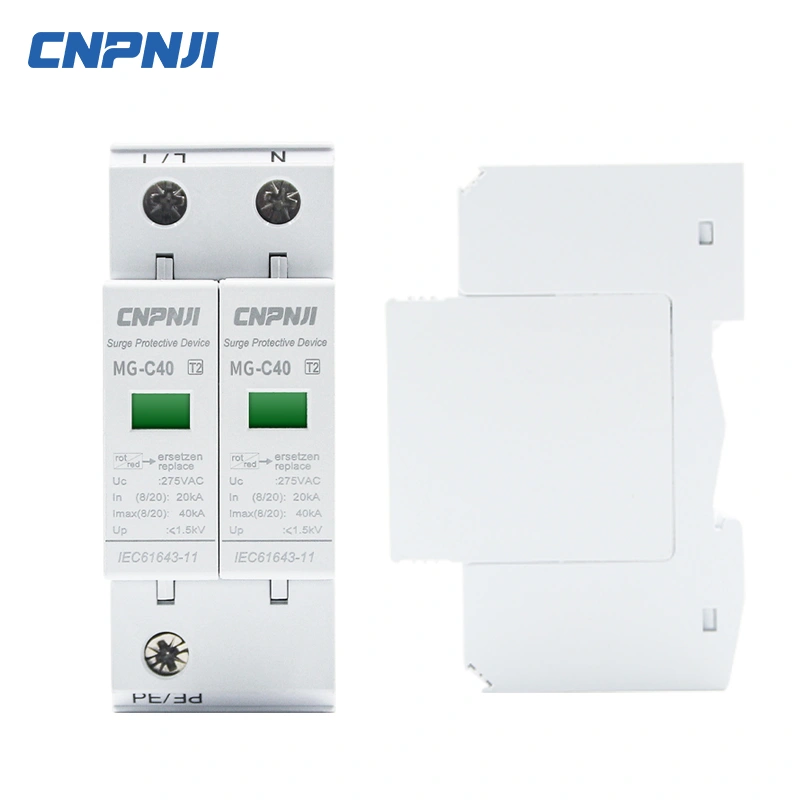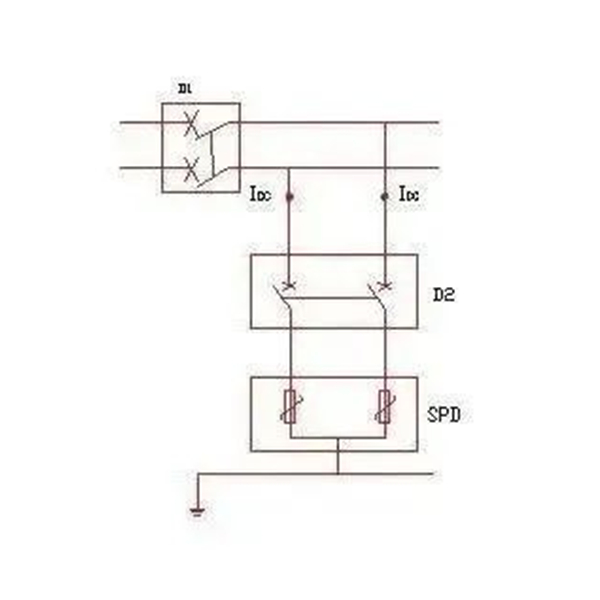How To Select Surge Protective Device?
What is the function of surge protective device? Most electrical designers must be very clear. As a serious natural disaster, lightning transient overvoltage and overcurrent caused by lightning can easily damage electrical equipment in buildings, especially electronic equipment, and cause direct and indirect economic losses to enterprises. Therefore, surge protection technology in lightning protection and safety protection has become a hot spot at present. So, how to select the surge protector?
With the development of science and technology, there are more and more types of electronic products and more and more applications. However, the impact withstand voltage level of these electronic products is generally lower than that of low-voltage distribution devices, so they are vulnerable to voltage fluctuations, namely surge voltage. The so-called surge, also known as transient overvoltage, is a kind of transient voltage fluctuation that occurs in the circuit. It usually lasts about one millionth of a second in the circuit. For example, in lightning weather, lightning pulse may continue to generate voltage fluctuation in the circuit.
220V circuit system will generate voltage fluctuations that can reach 5000 or 10000 V continuously and instantaneously, that is, surge or transient overvoltage. There are many lightning areas in China, and lightning is an important factor to generate surge voltage in the line, so it is very necessary to strengthen lightning protection in low-voltage distribution system.
The surge protector is the overvoltage protector. Its working principle is that when the transient overvoltage occurs on the power line and signal transmission line, the surge protector will discharge the overvoltage to limit the voltage within the voltage range that the equipment can withstand, thus protecting the equipment from voltage impact.
Under normal conditions, the surge protector is in a high resistance state without leakage current; When overvoltage occurs in the circuit, the surge protector will be triggered in a very short time, and the energy of overvoltage will be leaked to protect the equipment; After the overvoltage disappears, the surge protector will return to the high resistance state, which will not affect the normal power supply.

Design points and wiring form of surge protective device
1. Shortcomings of surge protector design
At present, there are still many deficiencies in the design of surge protective devices, which have caused many problems in the actual construction, and even caused project delay, as follows:
1) The description of the design is too simple, the meaning is not clear, and the installation requirements are not specific enough. It is easy to cause a lot of uncertainty during construction, which may cause damage to the electronic equipment to be protected or economic losses.
2) The design of surge protective device (SPD) is not flexible enough, sometimes even directly applies the fixed lightning protection construction drawing, and does not carry out targeted design according to the grounding system of the distribution system, which may lead to errors in the specific wiring and installation of SPD.
3) In the distribution system diagram, the design parameters of the surge protector are not complete, such as the voltage protection level UP, whether explosion-proof, maximum operating voltage Uc and other important parameters are not designed, or some parameters are inaccurate, resulting in the failure of the surge protector in actual operation or damage to electronic equipment.
4) The design specification is not detailed. Generally speaking, there should be a detailed design document for the surge protector design, such as the construction project overview, the design basis, whether the electronic information system is included, and the protection level of the surge protector design.
2. Design points of surge protector
1) Design description of surge protective device: project overview, lightning protection classification of buildings, design basis, lightning protection level of electronic information system, grounding system, cable access method, grounding resistance requirements, etc.
2) List the installation position of surge protective device, number of electric box, protection grade, quantity, basic parameters (nominal discharge current In or impact current lip, maximum operating voltage Uc, voltage protection level Up), etc.
• Spread collar, button-down front closures, buttoned flap chest pockets, slit side pockets
• Long sleeves with banded and buttoned cuffs, gradient pearl beading at the sleeves
• Faded denim, contrast topstiching, banded/buttoned hem, distressed details, unlined
• Model measurements: 5'10" height, 33.5" bust, 23.5" waist, 34.5" hips, wearing a size small
• Part of Sunset + Spring, a unique boutique of women’s trendy clothes inspired by America’s style capitals, NYC and L.A.
• This item is part of our 100% Bloomingdale's collection, featuring exclusive pieces you won't find anywhere else.
• Imported.
3. Wiring form of surge protective device in power distribution system
The grounding system of low-voltage power distribution system includes IT, TT, TN-S, and TN-C-S. Therefore, the surge protector should select different wiring details according to different grounding systems of low-voltage power distribution system. For example, when TN AC power distribution system is used for power supply, the distribution line from the main distribution box in the building needs to adopt TN-S grounding system.
What factors should be considered when selecting surge protective devices?
When the low-voltage power line introduced from the power grid is an overhead shielding layer grounded cable or buried cable, surge protective device may not be installed. When all or part of the low-voltage power lines are overhead lines, and the thunderstorm day in the area exceeds 25d/a, then the surge protector shall be installed to prevent the overvoltage caused by the introduction of lightning impulse along the power lines, so that the overvoltage level is below 2.5kV.
The surge protective device (SPD) is generally installed at the incoming line of the power supply. It can be installed inside the electrical device, or on the power line nearest to the building with the approval of the national transmission department, that is, at the overhead line transformer cable. If the electronic equipment has high requirements for overvoltage protection, or the occurrence of overvoltage will lead to relatively serious consequences, such as explosion or fire, or the ability of important electronic equipment to withstand overvoltage is particularly low, the installation of surge protective devices should also be increased.
The main factors to be considered when selecting surge protective devices in low-voltage distribution systems are as follows:
(1) Determine the voltage protection level Up of surge protective device. The voltage protection level Up refers to the maximum voltage measured at both ends of the surge protector under the action of the nominal discharge current, which is generally divided into six levels: 2.5, 2, 1.8, 1.5, 1.2 and 1.0, with the unit of kV. In order to protect the electrical equipment from voltage hazards, we should first consider making the impulse withstand voltage of the protected electrical equipment greater than the voltage protection level of the surge protector Up.
(2) The surge protector uses full protection mode. That is to say, surge protectors should be installed between L-PE, L-N and L-L lines to provide comprehensive protection for the line, which can ensure that no matter which line the lightning pulse generates overvoltage, the electronic equipment will be effectively protected. At the same time, the surge protector with full protection mode enabled can release energy at the same time to avoid the damage caused by the difference in the startup of the surge protector, thus extending the service life of the surge protector.
(3) Select the maximum sustainable operation voltage Uc of the surge protector. The maximum sustainable operation voltage refers to the maximum voltage that can be continuously applied to the surge protector without causing changes in the characteristics of the surge protector and conducting the surge protector.
(4) Select the appropriate maximum discharge current of surge protective device according to the environmental characteristics of the site. The maximum discharge current means that the surge protector can only pass 8/20 times μ The peak current of the current wave of s and the surge protector is not damaged. In fact, the surge protector has the maximum discharge current.
Protection analysis of surge protector itself:
Although the surge protective device (SPD) plays a very important role in protecting electronic equipment from overvoltage damage, the overvoltage generated in the circuit may sometimes exceed the scope of the surge protective device (SPD). Therefore, when the SPD works under overvoltage for a long time, it will also be damaged to varying degrees, which has seriously affected the service life of the SPD. For example, when the transient overvoltage is too high, the surge protector may be broken down and cause serious short circuit, as shown in the figure:

If the circuit breaker is not connected in series on the surge protector, the circuit breaker D1 will trip automatically. Because the fault current lcc still exists, the circuit breaker D1 will be closed again only after the surge protector is replaced, so the system will lose the continuity of power supply. The way to solve this problem is to connect a circuit breaker in series at the upper end of the surge protector. The rated current of the circuit breaker should be selected according to the maximum discharge current of the surge protector, so that the circuit breaker can work normally. The tripping curve adopts type C, and its breaking capacity must be greater than the maximum short circuit current at the installation location.
The breaking current of conventional miniature circuit breaker is not more than 10kA. It can be seen from the table that it is difficult to meet the requirement that the breaking capacity of the miniature circuit breaker must be greater than the maximum short circuit current at the installation site. Therefore, using fuse to protect surge protector is the right choice!
summary
Surge voltage is widespread. According to statistics, there is a surge overvoltage every 8 minutes in the national power grid, and 20% - 30% of computer failures are caused by surge voltage, so surge protection design is very necessary. The surge protection design is a preventive design. Only in this way can we protect our equipment from overvoltage as little as possible. The design of surge protective device should comprehensively consider various influencing factors. Only in this way can the surge protective device play a maximum protective role and more effectively protect electronic equipment from voltage damage.
